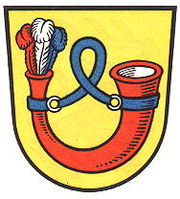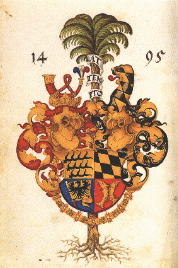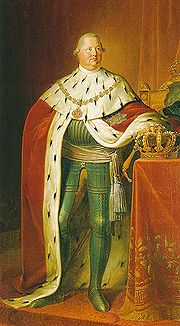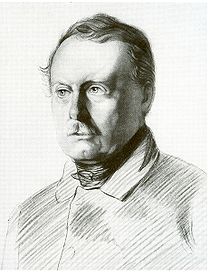
Rulers of Württemberg
Encyclopedia

This is a list of the rulers of the German state of Württemberg
Württemberg
Württemberg , formerly known as Wirtemberg or Wurtemberg, is an area and a former state in southwestern Germany, including parts of the regions Swabia and Franconia....
, originally a county and eventually a kingdom until the ruling dynasty was overthrown in 1918.
Counts of Württemberg to 1495

- Konrad I 1089–1122 (assumed)
- Konrad IIKonrad II, Count of WürttembergKonrad II , Count of Württemberg. He reigned from 1110 until 1143.Konrad's father is unknown, but he is believed to belong to the family of the counts of Veringen . The reason to believe so is due to the similarity of the arms of the Counts of Veringen with that of the Counts of Wirtemberg...
1110–1143 (assumed) - Ludwig ILudwig I, Count of WürttembergLudwig I of Württemberg was Count of Wirtemberg. He reigned from 1143 until 1158.Ludwig I is supposed to be the son of Konrad II and his wife Hadelwig. Together with his brother Emicho he appears from 1134 till 1154 respective 1139 till 1154 at the court of king Konrad III and emperor Friedrich I,...
1143–1158 - Ludwig IILudwig II, Count of WürttembergLudwig II. was the count of Württemberg from 1158 to 1181.He was married to Willibirg , daughter of Hartmann III, Count of Kirchberg....
1166–1181 - HartmannHartmann, Count of WürttembergHartmann I was the Count of Württemberg.Hartmann I and his brother Ludwig III both called themselves “Count of Württemberg”, at the time, so it is assumed that they administered the county together. Both were sons of Count Ludwig II...
1194–1240 - Ludwig IIILudwig III, Count of WürttembergLudwig III was Count of Württemberg. He was probably married to a daughter of count Adalbert III von Dillenburg, whose name is unknown...
1194–1226 - Ulrich IUlrich I, Count of WürttembergUlrich I, Count of Württemberg , also known as “Ulrich der Stifter” or “Ulrich mit dem Daumen”, was count of Württemberg from about 1241 until his death.-Life:...
1241–1265 - Ulrich IIUlrich II, Count of WürttembergUlrich II was Count of Württemberg from 1265 until 1279.Ulrich was the son of Ulrich I and Mechthild of Baden. He acceded power in 1265 at the age of 11 and thus, probably, was under the tutelage of Count Hartmann II of Grüningen. He is first mentioned sole in documents since 1270...
1265–1279 - Eberhard IEberhard I, Count of WürttembergEberhard I was Count of Württemberg from 1279 until his death. He was nicknamed 'der Erlauchte' or the Illustrious Highness.- Life :...
1279–1325 - Ulrich IIIUlrich III, Count of WürttembergUlrich III, , Count of Württemberg from 1325 until 1344.Ulrich was already strongly involved in politics during the reign of his father Eberhard I. In 1319 he handled a treaty with King Frederick I, the Handsome. He renewed this treaty after assuming reign in 1325, when Württemberg had temporarily ...
1325–1344 - Co–rulers:
- Eberhard II the JarrerEberhard II, Count of WürttembergEberhard II, called "der Greiner" , Count of Württemberg from 1344 until 1392.Eberhard II was son of Count Ulrich III of Württemberg and Sofie of Pfirt. He married Countess Elizabeth von Henneberg-Schleusingen on September 17, 1342...
1344–1392 (alone from 1362) - Ulrich IVUlrich IV, Count of WürttembergUlrich IV of Württemberg , Count of Württemberg. He reigned, together with his brother Eberhard II from 1344 until 1362....
1344–1362
- Eberhard II the Jarrer
- Eberhard IIIEberhard III, Count of WürttembergEberhard III of Württemberg der Milde , ruled from 1392-1417 as the Count of Württemberg, then a part of the Holy Roman Empire.-Life:...
1392–1417 - Eberhard IVEberhard IV, Count of WürttembergEberhard IV of Württemberg , Count of Württemberg.-Life:He was elder son of Count Eberhard III and Antonia Visconti. On 13 November 1397 he became engaged to Henriette of Mömpelgard...
1417–1419 - Ludwig ILudwig I, Count of Württemberg-UrachLudwig I , Count of Württemberg. He was a son of count Eberhard IV and Henriette of Montbéliard. He reigned from 1419 until 1450....
1419–1450 - Ulrich VUlrich V, Count of WurttembergUlrich V of Württemberg called "der Vielgeliebte" , Count of Württemberg. He was the younger son of Count Eberhard IV and Henriette of Mömpelgard.-Life:...
1419–1442, called the much loved
The Treaty of Nürtingen
Treaty of Nürtingen
The Treaty of Nürtingen was a treaty in German history, signed on 25 January 1442. It divided the county of Württemberg between count Ludwig I and his brother count Ulrich V. The Stuttgart half went to Ulrich and included the cities of Cannstatt, Göppingen, Marbach, Neuffen, Nürtingen, Schorndorf...
divided the County of Württemberg into two separate lines. Württemberg-Stuttgart with the capital Stuttgart
Stuttgart
Stuttgart is the capital of the state of Baden-Württemberg in southern Germany. The sixth-largest city in Germany, Stuttgart has a population of 600,038 while the metropolitan area has a population of 5.3 million ....
and Württemberg-Urach with the capital Urach
Bad Urach
Bad Urach is a town in the district of Reutlingen, Baden-Württemberg, Germany. It is situated 14 km east of Reutlingen, at the foot of the Swabian Alb, and is known for its spa and therapeutic bath.-History:...
.

Württemberg-Stuttgart line
- Ulrich VUlrich V, Count of WurttembergUlrich V of Württemberg called "der Vielgeliebte" , Count of Württemberg. He was the younger son of Count Eberhard IV and Henriette of Mömpelgard.-Life:...
, the much loved 1442–1480 - Eberhard VIEberhard II, Duke of WürttembergEberhard VI/II was count of Württemberg-Stuttgart since 1480 as Eberhard VI and Duke Eberhard II of Württemberg since 1496....
1480–1482, later Duke Eberhard II
Württemberg-Urach line
- Ludwig ILudwig I, Count of Württemberg-UrachLudwig I , Count of Württemberg. He was a son of count Eberhard IV and Henriette of Montbéliard. He reigned from 1419 until 1450....
1442–1450 - Ludwig IILudwig II, Count of Württemberg-UrachLudwig II , Count of Württemberg. The son of count Ludwig I and Mechthild of the Palatinate...
1450–1457 - Eberhard VEberhard I, Duke of WürttembergEberhard I of Württemberg . From 1459 till 1495 he was Count Eberhard V. From July 1495 he was the first Duke of Württemberg. He is also known as Eberhard im Bart ....
1457–1495
The Treaty of Münsingen
Treaty of Münsingen
The Treaty of Münsingen was signed on December 14, 1482. This accord officially re-united the divided county of Württemberg after it was divided by the Treaty of Nürtingen in 1442. The hereditary dispute between the Stuttgart part and the part of Urach were settled after 40 years...
reunited the two separate Lines under Eberhard V
Eberhard I, Duke of Württemberg
Eberhard I of Württemberg . From 1459 till 1495 he was Count Eberhard V. From July 1495 he was the first Duke of Württemberg. He is also known as Eberhard im Bart ....
in 1482. Eberhard obtained the title of Duke in 1495.
Dukes of Württemberg 1495–1803

| Name | Start term | | End term | | Note |
|---|---|---|---|
| Eberhard I Eberhard I, Duke of Württemberg Eberhard I of Württemberg . From 1459 till 1495 he was Count Eberhard V. From July 1495 he was the first Duke of Württemberg. He is also known as Eberhard im Bart .... |
21 July 1495 | 24 February 1496 | |
| Eberhard II Eberhard II, Duke of Württemberg Eberhard VI/II was count of Württemberg-Stuttgart since 1480 as Eberhard VI and Duke Eberhard II of Württemberg since 1496.... |
24 February 1496 | 11 June 1498 | |
| Ulrich Ulrich, Duke of Württemberg Herzog Ulrich von Württemberg succeeded his kinsman Eberhard II as Duke of Württemberg in 1498, being declared of age in 1503.-Early life:... |
11 June 1498 | January 1519 | deposed. |
| Württemberg annexed by Austria 1519–1534 | |||
| Ulrich Ulrich, Duke of Württemberg Herzog Ulrich von Württemberg succeeded his kinsman Eberhard II as Duke of Württemberg in 1498, being declared of age in 1503.-Early life:... |
May 1534 | 6 November 1550 | restored |
| Christoph Christoph, Duke of Württemberg Christoph of Württemberg, Duke of Württemberg ruled as Duke of Württemberg from 1550 until his death in 1568.... |
6 November 1550 | 28 December 1568 | |
| Ludwig III Ludwig III, Duke of Württemberg Ludwig, or Ludwig der Fromme, was a German nobleman. He was the fifth Duke of Württemberg from 1568 until his death.-Life:... |
28 December 1568 | 18 August 1593 | |
| Friedrich I Frederick I, Duke of Württemberg Friedrich I of Württemberg was the son of Georg of Mömpelgard and his wife Barbara of Hesse, daughter of Philip I, Landgrave of Hesse.... |
18 August 1593 | 29 January 1608 | |
| Johann Friedrich | 29 January 1608 | 18 July 1628 | |
| Eberhard III Eberhard III, Duke of Württemberg Eberhard III, Duke of Württemberg ruled as Duke of Württemberg from 1628 until his death in 1674.... |
18 July 1628 | 2 July 1674 | |
| Wilhelm Ludwig Wilhelm Ludwig, Duke of Württemberg William Louis of Württemberg was the ruler of the senior Duchy of Württemberg from 1674 until his death in 1677.... |
2 July 1674 | 23 June 1677 | |
| Eberhard Ludwig | 23 June 1677 | 31 October 1733 | |
| Karl Alexander Karl Alexander, Duke of Württemberg Charles Alexander of Württemberg was a Württemberg noble from 1698 who governed the Kingdom of Serbia as regent from 1720 until 1733, when he assumed the position of Duke of Württemberg, which he had held until his death.... |
31 October 1733 | 12 March 1737 | also ruler of Kingdom of Serbia Kingdom of Serbia The Kingdom of Serbia was created when Prince Milan Obrenović, ruler of the Principality of Serbia, was crowned King in 1882. The Principality of Serbia was ruled by the Karađorđevic dynasty from 1817 onwards . The Principality, suzerain to the Porte, had expelled all Ottoman troops by 1867, de... from 1720 |
| Karl Eugen Karl Eugen, Duke of Württemberg Charles Eugene , Duke of Württemberg was the eldest son of Duke Karl I Alexander and Princess Maria Augusta of Thurn and Taxis .-Life:... |
12 March 1737 | 24 October 1793 | |
| Ludwig Eugen Ludwig Eugen, Duke of Württemberg Ludwig Eugen, Duke of Württemberg , was the third son of Duke Karl Alexander and Princess Maria Augusta of Thurn and Taxis - 1 February 1756).-Marriage:... |
24 October 1793 | 20 May 1795 | |
| Friedrich Eugen Friedrich II Eugen, Duke of Württemberg Friedrich Eugen of Württemberg , the fourth son of Duke Karl Alexander and Princess Maria Augusta of Thurn and Taxis .-Royal duke:... |
20 May 1795 | 23 December 1797 | |
| Friedrich II Frederick I of Württemberg Frederick I William Charles of Württemberg was the first King of Württemberg. He was known for his size: at and about , he was in contrast to Napoleon, who recognized him as King of Württemberg.-Biography:... |
23 December 1797 | 25 February 1803 | |
In 1803, the Duke of Württemberg was raised to the rank of Elector
Prince-elector
The Prince-electors of the Holy Roman Empire were the members of the electoral college of the Holy Roman Empire, having the function of electing the Roman king or, from the middle of the 16th century onwards, directly the Holy Roman Emperor.The heir-apparent to a prince-elector was known as an...
of the Holy Roman Empire
Holy Roman Empire
The Holy Roman Empire was a realm that existed from 962 to 1806 in Central Europe.It was ruled by the Holy Roman Emperor. Its character changed during the Middle Ages and the Early Modern period, when the power of the emperor gradually weakened in favour of the princes...
. In 1806, the Empire was dissolved, and the Elector of Württemberg became an independent monarch with the title of King.
Elector of Württemberg 1803–1806
| Elector of Württemberg | ||||
| Württemberg Dynasty | ||||
| Image | Name | Began | Ended | Notes |
 | Friedrich II Frederick I of Württemberg Frederick I William Charles of Württemberg was the first King of Württemberg. He was known for his size: at and about , he was in contrast to Napoleon, who recognized him as King of Württemberg.-Biography:... | 25 February 1803 | 1 January 1806 | |
Kings of Württemberg 1806-1918
The Holy Roman Empire came to an end in 1806. The Elector of Württemberg, allied to Napoleon INapoleon I
Napoleon Bonaparte was a French military and political leader during the latter stages of the French Revolution.As Napoleon I, he was Emperor of the French from 1804 to 1815...
, anticipated its dissolution by becoming the ruler of an independent Kingdom of Württemberg in 1806.
| Kings of Württemberg | ||||
| Württemberg Dynasty | ||||
| Image | Name | Began | Ended | Notes |
 | Frederick I Frederick I of Württemberg Frederick I William Charles of Württemberg was the first King of Württemberg. He was known for his size: at and about , he was in contrast to Napoleon, who recognized him as King of Württemberg.-Biography:... Friedrich I | 1 January 1806 | 30 October 1816 | |
 | William I William I of Württemberg William I was the second King of Württemberg from October 30, 1816 until his death.He was born in Lüben, the son of King Frederick I of Württemberg and his wife Duchess Augusta of Brunswick-Wolfenbüttel .-First marriage:... Wilhelm I | 30 October 1816 | 25 June 1864 | Son of Frederick I. |
| Charles I Charles I of Württemberg Charles was the third King of Württemberg, from 25 June 1864 until his death in 1891.-Early life:He was born 6 March 1823 at Stuttgart, as HRH Charles Frederick Alexander, Crown Prince of Württemberg the son of William I, King of Württemberg and his third wife Pauline Therese of Württemberg .He... Karl I | 25 June 1864 | 6 October 1891 | Son of William I. Became a subordinate ruler in the German Empire German Empire The German Empire refers to Germany during the "Second Reich" period from the unification of Germany and proclamation of Wilhelm I as German Emperor on 18 January 1871, to 1918, when it became a federal republic after defeat in World War I and the abdication of the Emperor, Wilhelm II.The German... in 1871. | |
| William II William II of Württemberg William II was the fourth King of Württemberg, from 6 October 1891 until the abolition of the kingdom on 30 November 1918... Wilhelm II | 6 October 1891 | 29 November 1918 | Nephew of Charles I. Last king of Württemberg. Lost his throne in the German revolutions German Revolution The German Revolution was the politically-driven civil conflict in Germany at the end of World War I, which resulted in the replacement of Germany's imperial government with a republic... of 1918. | |
Because of a lack of male heirs under Salic law
Salic law
Salic law was a body of traditional law codified for governing the Salian Franks in the early Middle Ages during the reign of King Clovis I in the 6th century...
, on the death of Wilhelm II in 1921 the royal house had to reach back to the descendants of Friedrich II Eugen (ruled 1795–97). The line of the Duke of Urach
Duke of Urach
The title Duke of Urach was created in the Kingdom of Württemberg for Friedrich Wilhelm Alexander Ferdinand, Count of Württemberg on 28 March 1867, with the style of HSH."Urach" is pronounced Oo-raakh -Family:...
was excluded because of a morganatic marriage back in 1800 by its forbear Duke William
Duke William Frederick Philip of Württemberg
William Frederick Philip, Duke of Württemberg was a prince of the House of Württemberg and a minister for war.-Early life:...
, and so the succession devolved to the younger branch of Altshausen
Altshausen
Altshausen is a small Swabian municipality near Ravensburg, Baden-Württemberg, southern Germany.- Geography :Altshausen is situated in Upper Swabia, about 40 kilometers north of Lake Constance...
.
Another morganatic descendant of Friedrich II Eugen was Mary of Teck
Mary of Teck
Mary of Teck was the queen consort of the United Kingdom and the British Dominions, and Empress of India, as the wife of King-Emperor George V....
(1867–1953), who married the British king George V
George V of the United Kingdom
George V was King of the United Kingdom and the British Dominions, and Emperor of India, from 6 May 1910 through the First World War until his death in 1936....
when he was Duke of York.
Heads of the House of Württemberg since 1918
The legal line of succession of the house of Württemberg has continued to the present, although the house no longer plays any political role. For later rulers, see List of Ministers-President of Württemberg.- King Wilhelm IIWilliam II of WürttembergWilliam II was the fourth King of Württemberg, from 6 October 1891 until the abolition of the kingdom on 30 November 1918...
, 1918-1921. - Duke AlbrechtAlbrecht, Duke of WürttembergAlbrecht, Duke of Württemberg or Albrecht Herzog von Württemberg was a German Generalfeldmarschall and head of the Royal House of Württemberg...
, 1921-1939. - Duke PhilippPhilipp Albrecht, Duke of WürttembergPhilipp Albrecht, Duke of Württemberg was the son of Albrecht, Duke of Württemberg and Archduchess Margarete Sophie of Austria...
, 1939-1975. - Duke CarlCarl, Duke of WürttembergCarl, Duke of Württemberg is the current Head of the House of Württemberg.-Heir to House of Württemberg:...
, since 1975.
See also
- House of WürttembergHouse of WürttembergThe Württemberg family is a European royal family and a German dynasty from Württemberg. The House has its origins, according to recent research, probably in the vicinity of the Salian dynasty.-History:...
- Line of succession to the Württemberg throneLine of succession to the Württemberg throneThe monarchy of Württemberg came to an end in 1918 along with the rest of the monarchies that made up the German Empire. The last sovereign King of Württemberg was William II....
- History of WürttembergHistory of WürttembergWürttemberg developed as a political entity in south-west Germany, with the core established around Stuttgart by Count Conrad . His descendants managed to expand Württemberg, surviving Germany's religious wars, changes in imperial policy, and invasions from France. The state had a basic...
- Coat of arms of WürttembergCoat of arms of WürttembergThe coat of arms of the Kingdom of Württemberg shows an impalement of the three black antlers that represent Württemberg on the dexter side; and the three black lions passant of medieval Swabia on the sinister side, both on a gold field.It was formally adopted by King William on 30 December 1817,...
- UradelUradelThe German and Scandinavian term Uradel refers to nobility who can trace back their noble ancestry at least to the year 1400 and probably originates from leadership positions during the Migration Period.-Divisions of German nobility:Uradel : Nobility that originates from leadership positions held...
|-
|-
|-
|-

